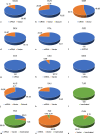Characteristics of Oral Adverse Effects following COVID-19 Vaccination and Similarities with Oral Symptoms in COVID-19 Patients: Taste and Saliva Secretory Disorders
- PMID: 39701050
- PMCID: PMC11936456
- DOI: 10.1159/000543182
Characteristics of Oral Adverse Effects following COVID-19 Vaccination and Similarities with Oral Symptoms in COVID-19 Patients: Taste and Saliva Secretory Disorders
Abstract
Although coronavirus disease 2019 (COVID-19) vaccines exhibit diverse side effects, taste and saliva secretory disorders have remained poorly understood despite their negative impact on the overall quality of life. The present study aimed to characterize oral adverse effects following COVID-19 vaccination and assess their similarities with oral symptoms in COVID-19 patients. A literature search was conducted in databases, including PubMed, LitCovid, and Google Scholar, to retrieve relevant studies. The narrative review indicated that a certain number of vaccinated people develop ageusia, dysgeusia, hypogeusia, xerostomia, and dry mouth, while they are rare compared with COVID-19 oral symptoms. The prevalence of oral adverse effects varies by country/region and such geographical differences may be related to the type of vaccine used. Similar to severe acute respiratory syndrome coronavirus 2 (SARS-CoV-2) infection, COVID-19 vaccination adversely affects taste perception and salivary secretion in females and older subjects more frequently than in males and younger subjects. Their impairments mostly appear within 3 days of vaccination, and bitter taste is specifically impaired in some cases. Considering that oral adverse effects following COVID-19 vaccination share some characteristics with oral symptoms in COVID-19 patients, it is speculated that the spike protein derived from COVID-19 vaccination and SARS-CoV-2 infection may be pathophysiologically responsible for taste and saliva secretory disorders. This is because such spike protein has the potential to interact with ACE2 expressed on the relevant cells, produce proinflammatory cytokines, and form antiphospholipid antibodies. Our results do not deny the advantages of COVID-19 vaccination, but attention should be paid to post-vaccination oral effects in addition to COVID-19 oral symptoms. Although coronavirus disease 2019 (COVID-19) vaccines exhibit diverse side effects, taste and saliva secretory disorders have remained poorly understood despite their negative impact on the overall quality of life. The present study aimed to characterize oral adverse effects following COVID-19 vaccination and assess their similarities with oral symptoms in COVID-19 patients. A literature search was conducted in databases, including PubMed, LitCovid, and Google Scholar, to retrieve relevant studies. The narrative review indicated that a certain number of vaccinated people develop ageusia, dysgeusia, hypogeusia, xerostomia, and dry mouth, while they are rare compared with COVID-19 oral symptoms. The prevalence of oral adverse effects varies by country/region and such geographical differences may be related to the type of vaccine used. Similar to severe acute respiratory syndrome coronavirus 2 (SARS-CoV-2) infection, COVID-19 vaccination adversely affects taste perception and salivary secretion in females and older subjects more frequently than in males and younger subjects. Their impairments mostly appear within 3 days of vaccination, and bitter taste is specifically impaired in some cases. Considering that oral adverse effects following COVID-19 vaccination share some characteristics with oral symptoms in COVID-19 patients, it is speculated that the spike protein derived from COVID-19 vaccination and SARS-CoV-2 infection may be pathophysiologically responsible for taste and saliva secretory disorders. This is because such spike protein has the potential to interact with ACE2 expressed on the relevant cells, produce proinflammatory cytokines, and form antiphospholipid antibodies. Our results do not deny the advantages of COVID-19 vaccination, but attention should be paid to post-vaccination oral effects in addition to COVID-19 oral symptoms.
Keywords: COVID-19; Oral adverse effect; Saliva secretory disorder; Taste disorder; Vaccination.
© 2024 The Author(s). Published by S. Karger AG, Basel.
Conflict of interest statement
The authors have no conflicts of interest to declare.
Figures








Similar articles
-
COVID-19 Oral Sequelae: Persistent Gustatory and Saliva Secretory Dysfunctions after Recovery from COVID-19.Med Princ Pract. 2023;32(3):166-177. doi: 10.1159/000531373. Epub 2023 Jun 3. Med Princ Pract. 2023. PMID: 37271130 Free PMC article. Review.
-
Treatments of COVID-19-Associated Taste and Saliva Secretory Disorders.Dent J (Basel). 2023 May 25;11(6):140. doi: 10.3390/dj11060140. Dent J (Basel). 2023. PMID: 37366663 Free PMC article. Review.
-
Characterization and Pathogenic Speculation of Xerostomia Associated with COVID-19: A Narrative Review.Dent J (Basel). 2021 Nov 10;9(11):130. doi: 10.3390/dj9110130. Dent J (Basel). 2021. PMID: 34821594 Free PMC article. Review.
-
Oral adverse events following COVID-19 and influenza vaccination in Australia.Hum Vaccin Immunother. 2023 Aug;19(2):2253589. doi: 10.1080/21645515.2023.2253589. Epub 2023 Sep 21. Hum Vaccin Immunother. 2023. PMID: 37734344 Free PMC article.
-
Prevalence of Chemosensitive Neurological Disorders of Smell and Taste and Association with Blood Groups in SARS-CoV-2 Patients: Cross-Sectional Study.Viruses. 2023 May 30;15(6):1277. doi: 10.3390/v15061277. Viruses. 2023. PMID: 37376577 Free PMC article.
Cited by
-
National Pharmacovigilance Assessment of Oral Adverse Events Following COVID-19 Vaccination in Germany (2020-2023).Int Dent J. 2025 Jul 19;75(5):100906. doi: 10.1016/j.identj.2025.100906. Online ahead of print. Int Dent J. 2025. PMID: 40684682 Free PMC article.
References
-
- Worldometer, a reference website of live world statistics. Available from: www.worldometers.info/coronavirus/ (accessed on 1 August 2024).
-
- COVID-19 Vaccine Tracker . COVID19 Vaccine Tracker (wpcomstaging.com). No longer being updated (accessed on 1 August 2024).
Publication types
MeSH terms
Substances
LinkOut - more resources
Full Text Sources
Medical
Miscellaneous

